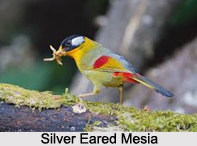 Silver-Eared Mesia is an Indian Bird that bears a scientific name `Leiothrix argentauris" has been described in the genus Mesia. It is widespread in South East Asia.
Silver-Eared Mesia is an Indian Bird that bears a scientific name `Leiothrix argentauris" has been described in the genus Mesia. It is widespread in South East Asia.
Category of Silver-Eared Mesia
Silver-Eared Mesia was once placed in the large Old World Babbler Family Timaliidae, but that family has recently been split with this species being placed with the Laughingthrushes in the new family Leiothrichidae. Silver-eared mesia is sometimes placed in its own genus Mesia, or in the genus Leiothrix with the red-billed leiothrix. There are seven described subspecies, with considerable variation in plumage between them. Further research is needed to establish if this represents a single species or not.
Habitat of Silver-Eared Mesia
Silver-Eared Mesia is generally resident although it has been reported as a winter migrant to Nameri National Park in Assam, which implies that the species may be an altitudinal migrant. The species has been introduced to Hong Kong from captive stock derived from caged birds.
Diet of Silver-Eared Mesia
The diet of the Silver-Eared Mesia is dominated by insects and their larvae, as well as fruit and to a lesser extent seeds. A study of the diet of feral birds in Hong Kong found that 87% of the faecal samples studied had the remains on insects in them, and 97% had the remains of fruit. The species will often associate in large groups of up to thirty individuals while foraging, and even forms groups during the breeding season. They will also join large flocks of other species in the forest, known as waves, which include other species of babblers. They generally feed closer to the ground, but may go as high as 5 metres up into the canopy.
Breeding of Silver-Eared Mesia
Silver-Eared Mesia is a seasonal breeder, with the season lasting from November to August, although the season starts later, in April, in the northern part of its range. Both the male and female are involved in building the nest, a deep cup of bamboo and other dead leaves lined with rootlets and fern fibres.
Nests of Silver-Eared Mesia
The nest of Silver-Eared Mesia takes about four days to construct and is placed near ground level or up to 2metres up in a bush. Underlying its relationship with the Red-Billed Leiothrix, the nest is said to be indistinguishable from the one of that species.
Eggs of Silver-Eared Mesia
The eggs of Silver-Eared Mesia are white with light but rich madder-brown spots. Between two to five eggs are laid in a typical clutch, with four being the typical number in India but two or three more common in Malaysia. Both parents incubate the eggs, with (at least in captivity) the female incubating the eggs during the night. The eggs are incubated for 13 to 14 days after the laying of the first egg. Both parents feed the chicks, which fledge after 12 days, and parental care lasts for a further 22 days after fledging.



















